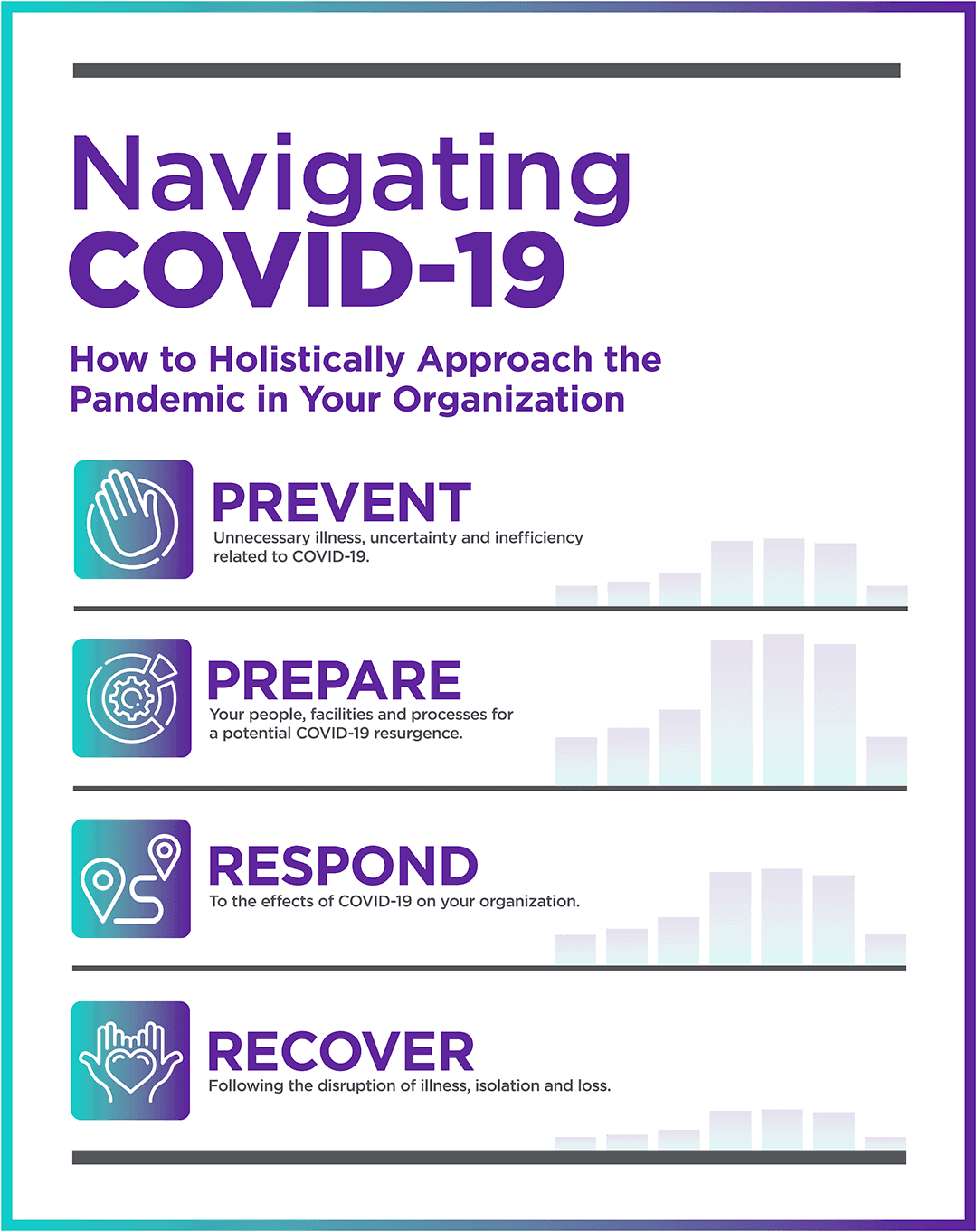COVID-19 Community Safety Resources and Solutions
Coronavirus Disease 2019 (COVID-19) is a respiratory disease caused by the SARS-CoV-2 virus. On March 11, 2020, the World Health Organization (WHO) characterized COVID-19 as a global pandemic and a new disease for which most people do not have immunity. This prompted governments to issue stay-home orders with subsequent impact on education, tourism, trade, food supply, financial markets and more.
By the end of July, the virus claimed more than 690,000 lives around the world. Some countries have managed to contain the virus’ spread and even returned to some normalcy, the U.S. never emerged from the first wave of infection. Many states experienced a surge in cases by reopening too soon. In July, cases in at least 18 states doubled.
Though several investigational vaccines are in clinical trials, they are still several months away from approval. As schools begin welcoming students back in the classroom (or virtually), and the regular flu season and fall/winter weather approach, all organizations must work diligently to provide safe environments, and remain nimble enough to change course as regulations continue to evolve.
The spread and impact of COVID-19 proves there is no such thing as “business as usual” anymore. The vital information and resources below are intended to help you and your organization confidently navigate this systemic crisis.
Navigating COVID-19
How to Holistically Approach COVID-19 and Future Pandemics in Your Organization.
- New cleaning/disinfecting recommendations for your facility
- Social-distancing guidelines and scheduling implications
- Employee testing and reporting
- Updates to your emergency operations and communications plans
- Staff health and engagement
Table of Contents
The Systemic Nature of COVID-19 and How It Impacts Communities
Leading Your Community Through COVID-19
Resources that Empower You to Lead with Confidence
Reopening Schools Safely
The Systemic Nature of COVID-19 and How It Impacts Communities
Topic 1COVID-19 is a systemic issue throughout society due to its capacity to disrupt every aspect of life (including education and business) as we know it. COVID-19, and any other potential pandemic, requires comprehensive planning and systems of thinking to ensure the physical safety and mental wellbeing of your team and organization.
In addition to adjustments to your daily operations, your organization will also need to plan and prepare for the potential impacts of isolation, job loss and other changes that may affect the mental and physical health of your team. This combination of COVID-19 implications reinforces a simple truth – being ready means understanding COVID-19’s potential impact.
Community Operations
Whether you employ essential workers who’ve been working back-to-back shifts, moved to fully remote operation or have furloughed employees, your organization has been faced with finding ways to adapt to unprecedented circumstances.
The Occupational Safety and Health Administration (OSHA) finds that informed workers who feel safe at work are less likely to be unnecessarily absent. If you’re already back to work, talk to employees to make sure they still feel safe. In fact, it’s impossible to over-communicate about safety right now. The more accommodating you are, the more productive people will be and can continue to thrive.
To mitigate COVID-19 impact in your community consider the following:
- Decreasing open business hours to disinfect your facility more frequently, sharing this plan with your employees
- Taking and documenting on-site employee temperatures daily
- Splitting shifts and/or limiting class sizes to ensure social distancing
- Allowing flexible hours for employees who are also caring for young children or elderly parents while working from home
- Rearranging classroom furniture or office layout
- Adjusting payment practices to avoid touching hands to exchange cash
- Implementing a more flexible sick leave policy
- Installing plexiglass or other transparent barriers where appropriate
The altered aspects of day-to-day operations coupled with the major life changes (and resulting physical and mental health implications) for the people powering your organization can have a serious impact. Implementing – and maintaining – thoughtful safety measures shows your commitment to safety. Investing extra time and money to protect people supports everyone’s success.
Watch this Work Safety Webinar with effective strategies for reopening and staying open. The panel of experts in the risk, insurance and communication fields provide key information for business leaders like you.
Community Mental Health
Prolonged isolation, the death of a loved one due to COVID-19 or the absence of a steady paycheck can negatively impact an individual’s mental health. Too much exposure to constant news coverage of the COVID crisis, as well as fiery debates on social media, don’t help either.
In the month of March alone, the Disaster Distress Helpline, a federal crisis hotline, saw a 891 percent increase in call volume compared to March 2019. Based on the previous link between unemployment and suicide rates, some experts are predicting an increase of up to 8,000 suicides, too.
Mental health problems, exacerbated by the pandemic, have the potential to drastically affect employees in all industries and sectors of our society. Providing access to mental health education and resources, like counseling and tele-health appointments, can have a positive impact on your workforce. You can help your staff by reducing the stigma around these topics through open conversations, sharing of resources and keeping your teams connected. Make sure your workforce knows they are not alone.
Community Physical Health
Maintaining a physically healthy population is critical to your ongoing success. Enforce a self-quarantine for any employees exposed to COVID-19, regardless of visible symptoms. Even if you have to reduce business hours because of limited staffing availability, remember that these procedures protect the physical health of everyone else. It’s not only the business that is at risk – it’s also a risk to the safety of the entire community.
Vulnerable populations require additional protection due to their higher risk for serious illness upon contracting the virus. These include ages 65+, the immunocompromised, or people with pre-existing conditions. Look for ways to minimize face-to-face contact for those who may be vulnerable. You can do this by structuring your work environment to allow for appropriate social distancing or providing the option to work remotely.
Also, ensure your community has a plan for how to deal with someone who becomes ill while on your property. Designate an isolation room within the facility, and create procedures around how to care for this person and clean when they leave. These kinds of details are spelled out in our Return to Work/School Playbook and Checklist resources below.
Leading Your Community Through COVID-19
Topic 2Effective planning gives your organization a roadmap to anticipate what’s ahead. Since the future is a bit uncertain, and guidelines are changing every day, the ability to remain nimble will help your business stay open. Start with a solid plan, but be ready and willing to adapt to changing regulations and constantly communicate with both internal and external audiences. This shows people they can be confident in your organization, and ultimately allows it to thrive.
Identify and manage the full spectrum of safety needs to lead your operation using the four pillars of emergency management: prevention, preparation, response and recovery.

Prevent

Prepare

Respond

Recover

Prevent
Focus your organization’s prevention efforts on limiting transmission, implementing safety audits and updating prevention processes related to the pandemic.
Stay ahead of what’s to come by:
- Following and implementing CDC/Public Health guidelines for physical safety to prevent the spread of the disease.
- Encourage everyone to stay home if they are sick.
- Determine if your operation demands additional safeguards and how you’ll apply them.
- Research and learn local county and city public health guidelines.
- Developing support plans for the transition from remote work or learning back to on-site operations (if you haven’t already done so).
- Consider how adding staff or adjusting employee responsibilities to help adhere to new safety guidelines (facility cleaning, health monitoring, etc.) can make the operation run more smoothly.
- Understanding why absenteeism may rise and how to manage accordingly.
- Consider cross-training workers in various jobs to cover absences or fulfill peaking services.
- Build in exposure-reducing measures like staggered work shifts.
- Be flexible with sick leave policies for employees caring for sick family members or children due to school or child care closures.

Prepare
The right plan may remove some of the stress related to safety and work expectations. Take the time to think through what is required to lead as the current public health situation evolves.
Be prepared by:
- Auditing and updating emergency operations plans.
- Develop communication and support plans including procedures for reporting when community members are sick or experiencing symptoms of COVID-19.
- Identify possible future threats to your company like interrupted supply chains or delayed deliveries.
- Have emergency plans in place, along with training, to easily absorb change.
- Thinking at a micro level. If you have multiple facilities in different states or communities, don’t bank on the same plan for each location. Health regulations and the needs of your workforce or students in each unique community will vary.
- Developing security standards for remote operations.
- Think about telecommuting employee network access and ways to limit disruption and downtime.
- Develop routine security testing processes for remote workforce.
- Identify gaps in resources to mitigate interruption.
- Considering how your facilities could be used to serve the local community in crisis.
- Determine the government requirements and permits needed to make your facility available.

Respond
COVID-19 crisis response efforts are ongoing, but there are several ways organizations can improve response to both the disease itself and the societal issues that it creates. A good response starts with training the people in your building to understand the response plan. Good training enables confident actions in unexpected situations.
Showcase a smart response by:
- Ensure efficient, two-way communication across the organization and trusted sources internally to combat misinformation.
- Show, don’t just tell, your internal and external audiences what safety measures you have in place. This builds confidence in your organization because visible examples help manage expectations.
- Provide adequate and appropriate training and informational material about worker health and safety, including proper hygiene practices and the use of any workplace controls (such as personal protection equipment).
- Launch a forum for answering worker (or parent) concerns and internet-based communications.
- Inform staff how to respond if they, or someone they know, gets sick.
- Partner with the local health department to control outbreaks before they happen. Use their guidance to determine what, if any, areas of your building need to shut down after possible exposure.
- Build a Behavioral Threat Assessment team within your organization to monitor and assess dangerous behavior and threats before they turn into violence.
- Provide documentation on how to share sensitive information while working/learning remotely.
- Keep staff engaged and create a healthy work culture at a distance.
- Adjust your social activities to a virtual format wherever possible.

Recover
Stay aware of the nuances and safety issues that continue to emerge. Plans that include preventing and preparing to deal with fallout from any public health crisis enable a stronger and faster recovery.
Keep moving forward by:
- Developing or collecting up-to-date resources to help staff return (or continue) to work without fear.
- Embracing and supporting employee and/or student mental health initiatives.
- Updating your recovery plan to account for multiple phases of operation.
- Consider local economic impact and how your organization may need gradual steps to return to full functionality.
- Identify additional financial resources – like government and community foundation grant programs.
- Understanding how your organization can assist recovery efforts for others in the community.
Free Resource for Organizational Leaders
See how the Path to Safety can safely guide organizations through a global pandemic.
See the expanded infographic with the proven step-by-step methodology for leading organizations through pandemics and other crises.
Resources that Empower You to Lead with Confidence
Topic 3
Leaders across all types of communities want professional support and tools to enhance safety in each new phase of this pandemic and beyond. Forward-thinking solutions already exist, leveraging innovative technology that empowers you to lead with confidence.
We’re also providing a constant stream of resources from our safety experts to help you reopen and stay open. Check back regularly for new insights.
Covid-19 Resources
Navigate360: Guiding Your School Towards a Future of Resilience, Well-Being, and Empowerment
Navigate360 partners with SSIS CoLab to offer universal student well-being assessment and mental health screener and intervention programs.
Recognizing World Behavior Analysis Day
Behavior analysis is a broad field with many applications, including general and special education, behavior disorders, intellectual and developmental disabilities, and autism spectrum disorders. In the educational setting, behavior analysis plays a crucial role in...
Implementing SEL & PBIS in High School
Many people assume that social-emotional learning (SEL) instruction and positive behavior interventions and supports (PBIS) initiatives are primarily the domain of PK-8 classrooms, when in fact SEL and PBIS can be a vital part of the high school experience. By the...
Additional COVID-19 Safety Resources for Communities
Workplace Resources
- Occupational Safety and Health Administration (OSHA)
- OSHA Employer Guidance Publication
- CDC Resources for Emergency Health Professionals
- The CDC Coronavirus Communication Resources
- CDC PPE FAQs
- CDC Instructions for Cleaning and Disinfecting your Facility
- A Playbook for Returning to School Buildings
- A Playbook for Returning to the Workplace
- COVID-19-Related Mental Health Strain Likely to Increase Workplace Violence
Mental Health Resources
- If you or someone in your household may harm themselves or someone else, contact the National Suicide Prevention Lifeline at 1-800-273-TALK (1-800-273-8255).
- The free and confidential Online Lifeline Crisis Chat allows you to connect to a skilled, trained counselor in your area.
Reopening Schools Safely
Topic 4Reopening schools requires comprehensive planning and systemic changes that ensure the physical safety and mental wellbeing of your students and staff.
Reopening Schools
Reopening schools requires comprehensive planning and systemic changes that ensure the physical safety and mental wellbeing of your students and staff.
- Facilities
- Assess facility buildings and equipment before students set foot on campus.
- Establish regular cleaning and disinfecting protocols.
- Determine the best response to those who become sick while at school.
- Transportation
- Assess your fleet and mark for social distancing.
- Establish regular cleaning and disinfecting.
- Determine new ventilation needs to reduce the spread of infection.
- People
- Establish consistent mask-wearing policy for staff and students.
- Protect and serve the entire school population.
- Prepare for remote learning at any time.
To accommodate the needs of families who aren’t able or willing to send kids in person, schools must also offer virtual and/or blended learning options. There’s much to accomplish before students return on campus, and it will take a team effort to ensure ongoing health and safety of the entire school population.
Communities We are Helping Through the Crisis
Discover Solutions for Your Community

